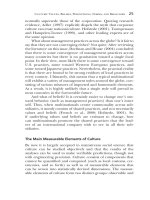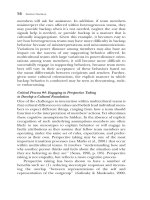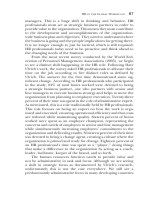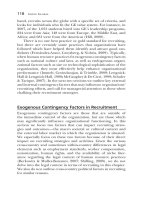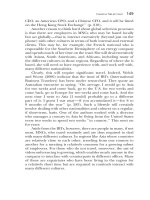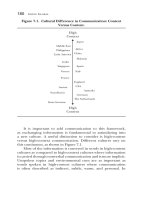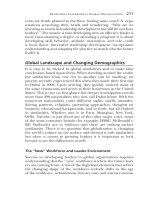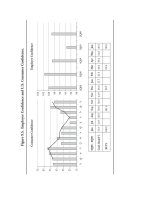Going Global Practical Applications and Recommendations for HR and OD Professionals in the Global Workplace J-B SIOP Professional Practice Series by Kyle Lundby, Jeffrey Jolton and Allen I. Kraut_7 potx
Bạn đang xem bản rút gọn của tài liệu. Xem và tải ngay bản đầy đủ của tài liệu tại đây (487.95 KB, 28 trang )
Recruitment in a Global Workplace 131
Endogenous Contingency Factors in Recruitment
Various organizational level or internal factors influence an orga-
nization’s recruiting strategies. In this section we elaborate on
two factors that can have an impact on recruiting strategies
and outcomes: the size of the organization, and its technolog-
ical sophistication. Although various indicators of size such as
sales volume or other performance measures are used, the most
common indicator of size is the number of employees, as this
indicates both current capacity for work and current performance
level (Scott, 2003). In this section we also use the word size to
denote number of employees, as this has a direct relationship with
human resource strategies. Technological sophistication of the
organization implies organizational comfort with leveraging tech-
nology, and this also has a direct relationship with human resource
strategies, especially attracting and tracking candidates. It is quite
possible that large global organizations are also technologically
more sophisticated than small local setups.
Organizational Size
Organizational size influences the structure of departments,
their functioning, and strategies of an organization. As organi-
zations grow, a simple informal model of control through mutual
adjustment and social interactions gives way to more standard-
ized control (Mintzberg, 1979). Human resource strategies and
recruitment practices in particular also become more formal,
bureaucratic, and resource intensive than practices of smaller
organizations (Fisher, Schoenfeldt, & Shaw, 2006). Large organi-
zations can follow two broad strategies when recruiting: formalize
recruiting processes across the organization, and leverage the
internal labor market. This is an especially important point for
large global organizations that can systematically comb their own
ranks to spot and deploy talent where required.
Formalizing recruitment procedures. Formalizing external
recruitment procedures is important because large organiza-
tions are involved in recurring transactions (such as recruiting
many people) and can economize costs per recruit (Bhattacharya,
2008). Recruiting costs of large organizations such as Infosys
can be amortized over many hiring decisions. Further, large
132 Going Global
organizations are more likely to have dedicated recruiters who
are formally trained. Larger organizations are also more likely
to use more screening procedures than smaller organizations
because large organizations have the resources available to design
or acquire (and validate) multiple screening devices such as psy-
chological tests, physical abilities tests, and so forth (Birkinshaw,
2008). Finally, formalization is important as large organizations
face institutional pressures and public scrutiny and are answerable
to multiple stakeholders (Barber, Wesson, Roberson, & Taylor,
1999; Kossek, 1987).
Leveraging the internal labor market. Considering that formal
procedures in recruiting can be seen through previous sections
and examples, this section will focus on recruiting in the large
internal labor market that exists in large organizations. A 2004 poll
conducted by Development Dimensions International showed that
internal recruiting for management positions was at 53% within
the 350 organizations polled. This was an increase from 44% in
1999 (Little, 2007).
Why do (or should) organizations recruit from their internal
labor pool? Recruiting from within has many advantages. It may
be relatively cheaper to attract and hire candidates from within
the organization than outside, it is a great retention tool, and,
finally, a great way to develop and nurture talent (Plemmons,
2009). In fact, a recent report shows that Skanska, one of the
world’s leading construction groups, which has a presence across
19 countries and employs over 60,000 employees worldwide, saved
several million dollars last year by recruiting internally (Resourc-
ing, 2009). Recognizing the importance of recruiting from within,
organizations such as General Electric and United Parcel Service
put great emphasis on developing talent that can be leveraged
in multiple units of the organization when needs arise (Fisher,
Schoenfeldt, & Shaw, 2006).
How do organizations tap into the available labor pool to
fill positions as they open up? Consider the cases of Cisco and
Houston’s M. D. Anderson Cancer Center. Cisco created
and launched a software application called the Pathfinder. This
software, used by about 20% of the organization’s engineers to
change jobs, allows employees to load their r´esum´es into the
system, sift through openings by location, career level, and other
Recruitment in a Global Workplace 133
criteria, and then contact the hiring managers in other business
units directly (Kiger, 2003). When employees self-attract and
apply in some organizations, internal recruiters at M. D. Anderson
actively look at the availability of internal talent and projected
hiring needs, and target key people (Plemmons, 2009). Managers
at ANZ Financial Services (Australia and New Zealand Banking
Group Limited) actively mentor junior colleagues, and between
half to one-third of the financial planners are recruited from dif-
ferent units of the organization (Egan, 2007). Other organizations
such as Merck and the U.S. military have leveraged technology
to spot and recruit internal candidates. These organizations use
human resources information systems such as SAP and PeopleSoft
to tap into the internal labor pool (Bohlander & Snell, 2004).
Organizations endowed with large internal labor markets can
also use a process called job posting and bidding to leverage
internal talent. This process can be as simple as posting an
opening in the cafeteria to putting it up on the internal Web
server. Texas Instruments, Xerox, and Cisco, to name a few of
many organizations, do this quite effectively (Bohlander & Snell,
2004). Overall, size affords recruiters and hiring managers a large
internal pool of talent, and possibly a formalized predetermined
recruitment process that can be used across locations.
Technological Sophistication
The final contingency we discuss in this chapter is the level of orga-
nizations’ ever-expanding technological sophistication. Whether
the organization is recruiting internally or externally, within social
networks or outside, or in tight or loose labor markets, organiza-
tions can effectively use technology to attract candidates. After all,
the world is getting smaller and recruits are sometimes just a click
away (Friedman, 2006). In the sections below we describe how
various organizations have leveraged technology to recruit candi-
dates. We identify three broad recruiting trends in this section:
leveraging social networking sites, deploying creative Internet
technologies, and creating attractive organizational Web sites.
Leveraging social networking sites. Social networking sites
continue to gain enormous popularity and momentum. To target
specific types of candidates, and to broaden their recruitment
134 Going Global
efforts, organizations are increasingly trying to tap into the
large number of people active on social networking sites such
as LinkedIn. Web sites like Orkut, Facebook, and other social
media sites are the new haunting places for human resource pro-
fessionals these days to scout for talent that can deliver results
(Shah, 2007). Technology organizations like Wipro, and Tata
Consultancy Services have started recruiting heavily through social
media networks. Ernst and Young also heavily leverages Facebook
to target students (Sullivan, 2008b). It’s not just the traditional
civilian large organizations that are leveraging social networking
sites to recruit people. The U.S. Central Intelligence Agency, the
U.S. Navy, and the Army are also using Facebook and Twitter
to recruit talent (Bruce, 2007; MSNBC report, 2009). In fact, a
recent survey by Development Dimensions International showed
that 25% of recruiters used social networking sites for information
about candidates, and 52% of them have used online informa-
tion to make selection decisions (Recruiter, 2009), a trend that is
likely to continue considering the growing millions of active and
passive job seekers that throng such Web sites.
Along with organizations, professional head hunters across
the world are also making social networking sites a part of their
recruitment strategy, and are setting up dedicated resources to
sift through these sites for global recruiting (CyberMedia, 2007;
Sachitanand & Bhattacharya, 2008). LinkedIn is becoming such
a popular recruiting source the world over that professional
recruiters are demanding the same full access that organizations
have in order to have access to more candidates (Goodfel-
low, 2008).
Deploying creative Internet technologies. Organizations are
also increasingly using creative technologies to spot and attract
candidates. Some organizations are using the Web site X-raying
technique to access the passive talent pool. This technique allows
recruiters to see all pages on an organizational Web site that are
not protected by a firewall. X-rays can be done using the advanced
search feature on Web sites such as Google or Hotbot. Another
technique used by organizations is called Web site flipping. Flip-
ping allows recruiters to find all Web pages linked to a given Web
site. For example, recruiters can access individual home pages
that are linked to organizational Web sites. Such cross-linked sites
Recruitment in a Global Workplace 135
can yield valuable passive candidate information. One has to keep
in mind though, that such techniques are not legal throughout
the world.
Yet another technique to get access to job seekers is using
name-generating software. This software can be purchased and
allows recruiters to sift through the Internet to generate names,
profiles, and resumes of individualsmeetingthe search parameters
specified by the recruiter. Intel, in 2004, worked with a vendor to
create such customized software. This software ‘‘crawled’’ through
a list of pre-programmed sites to access very specific types of candi-
dates (Corporate Leadership Council and Recruiting Roundtable,
2006). Valero also automated part of their recruiting efforts and
programmed ‘‘Web spiders’’ to crawl, retrieve, and upload can-
didates into their internal applicant tracking system based on
both current and projected needs (Sullivan, 2006c). Wachovia,
on the other hand, paid for this service instead of developing
one in-house. Various vendors such as ZoomInfo, LinkedIn, and
SearchExpo provide this service for a fee. Other technology-savvy
organizations such as Microsoft encourage and actively leverage
recruiter and employee blogs. Such blogs can be used to target
passive job seekers who are surfing the net. They can be used to
build a relationship with the potential employee as well as create
an organizational brand.
Creating attractive organizational Web sites. The final trend
we discuss is how organizations can leverage their own Web site
to attract candidates. Skoda Minotti, for example, uses a rather
innovative way to attract applicants. Their Web site hosts a game
similar to ‘‘photo audit,’’ where players spot differences in pho-
tos within a given time and have their scores displayed in a
competitive fashion against other players. Potential applicants
from various campuses, who are playing the online game, get
ranked against each other and can see scores of others from
their schools. High scorers are given rewards. This increases Web
traffic to Skoda’s site and gives Skoda a database of potential
hires (Ebenstein, 2008). Skoda Minotti and The Cheesecake Fac-
tory both use a promotional recruitment video on their Web
sites that explains how the organization runs, how people are
such a key asset, and how the potential recruit will enjoy work-
ing for this great organization. For organizations that cannot
136 Going Global
host videos on their own Web sites, there are other cyber places
such as VlogYourJob.com. VlogYourJob.com is the United King-
dom’s first online video recruitment Web site, created by Indigo
Red, a U.K based recruitment consultancy. This Web site encour-
ages organizations to post vlogs—online short videos—as job
advertisements. It also allows recruiters to give potential candi-
dates a taste of what it’s like at the organizations by posting a
video about their working environment (Marketing Week, 2007).
Thus, organizations that have technological sophistication can
leverage both in-house and externally developed technologies to
recruit.
Conclusion
We defined recruiting as a process of finding and attracting the
right candidates and encouraging them to apply for certain posi-
tions. We drew upon recruitment research and organizational
examples to outline various contingencies that managers should
consider when undertaking recruitment initiatives. So what does
all this mean for your own recruiting efforts? How can you create
an effective recruiting strategy in your organization? As outlined
in Table 5.1, we especially argued for the importance of the macro
sociocultural context and the external labor market as the two
key exogenous factors that have an impact on recruitment. We
also pointed to the importance of organizational size and evolving
technological sophistication as the two key endogenous factors
that affect recruitment. For each of these contingencies, we have
distilled lessons based on organizational theory and examples. For
instance, when discussing the social context, we have argued for
the importance of sensitizing and training global managers about
different values and expectations across the globe, and of creating
clear job descriptions that can be implemented irrespective of
where the managers recruit from. Further, on the topic of the
external labor context, we have highlighted the importance of
creating salience in the minds of potential applicants and tapping
passive candidates in a scarce labor market. In terms of an abun-
dant labor market, we have pointed out the importance of creating
multiple rounds of recruiting, leveraging external databases, inter-
nal employees, and targeting ex-employees. We have argued that
Recruitment in a Global Workplace 137
large organizations can formalize procedures and tap the internal
labor pool. Finally, technology can be leveraged to attract candi-
dates. Specifically, organizations can leverage social networking
sites, deploy creative Internet technologies, and create effective
and attractive organizational Web sites.
Overall, we recognize that no two organizations are the same,
and contingencies and recruitment strategies differ per organiza-
tion. Although there is no magic formula for recruiting, and some
of these techniques may force you to think outside the box, the
benefits of charting a well-defined recruiting strategy are clear.
References
Alsahlawi, K. A., & Gardener, E. P. (2004). Human resource and eco-
nomic development: The case of Saudi Arabia. Journal of Third
World Studies, 21, 175–190.
Aycan, Z. (2005). The interplay between cultural and institutional/
structural contingencies in humanresourcemanagement practices.
International Journal of Human Resource Management, 16, 1083–1119.
Aycan, Z., Al-Hamadi, A. B., Davis, A., & Budhwar, P. S. (2007). Cultural
orientations and preferences for HRM policies and practices: The
case of Oman. International Journal of Human Resource Management,
18, 11–32.
Barber, A. E. (1998). Recruiting employees. Thousand Oaks, CA: Sage.
Barber, A. E., Wesson, M. J., Roberson, Q. M., & Taylor, M. S. (1999).
A tale of two job markets: Organizational size and its effects on
hiring practices and job search behavior. Personnel Psychology, 52,
841–867.
Berkowitz, P., & Muller-Bonanni, T. (2007). International labor and employ-
ment law: A practical guide (International Practitioner’s Deskbook Series).
Chicago: American Bar Association.
Bhattacharya, S. (2008). From talent crunch to cash crunch. Business
Today, 17, 126–129.
Birkinshaw, J. (2008). Infosys: Computing the power of people. Business
Strategy Review, 18–23.
Bohlander, G., & Snell, S. (2004). Managing human resources. Mason, OH:
Thomson/South-Western.
Boswell, W. R., Roehling, M. V., LePine, M. A., & Moynihan, L. M. (2003).
Individual job-choice decisions and the impact of job attributes and
recruitment practices: A longitudinal field study. Human Resource
Management, 42, 23–37.
138 Going Global
Breaugh, J. A. (2008). Employee recruitment: Current knowledge and
important areas for future research. Human Resource Management
Review, 18, 103–118.
Brewster, C., Wood, J., & Brookes, M. (2008). Similarity, isomorphism
or duality? Recent survey evidence on the human resource man-
agement policies of multinational corporations. British Journal of
Management, 19, 320–343.
Bruce, C. (2007). CIA gets in your Face(book). Retrieved on May 9,
2009, from www.wired.com/techbiz/it/news/2007/01/72545.
Budhwar, P. S. (2001) Doing business in India. Thunderbird International
Business Review, 43, 549–568.
Budhwar, P. S. (2003). Employment relations in India. Employee Relations,
25, 132–148.
Budhwar, P. S., & Khatri, N. (2001). A comparative study of HR prac-
tices in Britain and India. International Journal of Human Resource
Management, 12, 800–826.
Charan, R., & Colvin, G (2000). The right fit. Fortune, 141, 226–238.
Chatman, J., O’Reilly, C., & Chang, V. (2005). Cisco Systems: Devel-
oping a human capital strategy. California Management Review, 47,
137–167.
Collins, C. J. (2007). The Interactive effects of recruitment practices
and product awareness on job seekers’ employer knowledge and
application behaviors. Journal of Applied Psychology, 92, 180–190.
Corporate Leadership Council Report (2006a). Part-time employee
recruiting strategies.
Corporate Leadership Council Report (2006b). Recruiting from a global
talent pool.
Corporate Leadership Council and Recruiting Roundtable Report
(2006). Creating a passive candidate recruiting strategy.
CyberMedia India Online Ltd. (2007). Network sites become networking
platforms. Retrieved on February 17, 2009, from www.ciol.com/
News/News-Reports/Networking-sites-become-recruitment-
platform/131008111373/0/.
Davenport, T. (2006). Competing on analytics. Harvard Business Review,
84, 99–107.
Despeignes, P. (2005). Offshoring: A reality check. Fortune,89.
Dessler, G. (2008). Human resource management. New Delhi: Prentice-Hall
of India.
Ebenstein, J. (2008). Hunting for CPAs: Recruiting and retention tactics.
CPA Practice Management Forum, 4,5–7.
Egan, L. (2007). Digging deeper for productivity gains. Money Manage-
ment, 21, 40–41.
Recruitment in a Global Workplace 139
Farrell, D. & Grant, A. J. (2005). China’s looming talent shortage.
McKinsey Quarterly, 4, 70–79.
Fern´andez-Araoz, C. (2007). Making people decisions in the new global
environment. MIT Sloan Management Review, 49, 16–20.
Fern´andez-Araoz, C., Groysberg, B., & Nohria, N. (2009). The definitive
guide to recruiting in good times and bad. Harvard Business Review.
87, 74–84.
Fisher, C. D., Schoenfeldt, L. F., & Shaw, J. B. (2006). Human resource
management. New Delhi: Houghton Mifflin.
Friedman, T. L. (2006). The world is flat: A brief history of the twenty-first
century. New York: Farrar, Straus & Giroux.
Fugure, B. (2009). Movies with a message: Deloitte employees unleash
their inner director and make the company’s first-ever film festival
a success. Communication World, 40–41.
Goodfellow, C. (2008). Anger over limited access to LinkedIn. Recruiter
News,6.
Guthridge, M., Komm, A. B., & Lawson, E. (2008). Making talent a
strategic priority. McKinsey Quarterly, 1, 48–59.
Hill, C. W. L. (2008). Global business today. New York: McGraw-Hill/
Irwin.
Immelt, J. R., Govindarajan, V., & Trimble, C. (2009). How GE is
disrupting itself. Harvard Business Review,forthcoming.
Institute of Management and Administration, Inc (2008). Best practices:
How top employers are using web-based recruitment technologies
now.
International Labour Organization Report. (2009). Global employment
trends.
Jackson, S., & Schuler, R. (1995). Understanding human resource man-
agement in the context of organizations and their environments.
Annual Review of Psychology, 46, 237–264.
The job show—India’s first televised job hunt by Naukri.com and CNBC
TV. (2006). Human Capital, 9,8.
Kanungo, R. N., & Jaeger, A. M. (1990). Introduction: The need for
indigenous management in developing countries. In A. M. Jaeger
and R. N. Kanungo (Eds.), Management in Developing Countries.
London: Routledge.
Kiger, P. J. (2003). Cisco’s Homegrown Gamble. Workforce, 82, 28–32.
Kossek, E. (1987). Human resources management innovation. Human
Resource Management, 26, 71–92.
Kulkarni, M., Lengnick-Hall, M. L., & Valk, R. (2010). Employee per-
ceptions of repatriation in an emerging economy: The Indian
experience. Human Resource Management,forthcoming.
140 Going Global
Laurent, A. (1986). The cross-cultural puzzle of international human
resource management. Human Resource Management, 25, 91–102.
Leat, M., & El-Kot, G. (2007). HRM practices in Egypt: The influ-
ence of national context? International Journal of Human Resource
Management, 18, 147–158.
Lee, J. (2007). Transforming the HR function from reactive to proactive:
A CISCO case study. Human Capital, 11, 28–31.
Lengnick-Hall, C A., & Lengnick-Hall, M. L. (1988). Strategic human
resources management: A review of the literature and a proposed
typology. Academy of Management Review, 13, 454–470.
Little, D. (2007). Promotional material. Journal of Property Management,
72, 38–41.
Marketing Week (August 16, 2007). Indigo Red unveils UK’s ‘first’
video jobs website. Retrieved on April 8, 2009, from www.mad
.co.uk/Main/News/Disciplines/Media/Digital/Articles/
e5d92fac9b704bd4b5695455450f911b/Indigo-Red-unveils-UK’s-
‘first’-video-jobs-website.html.
McConnon, A., & Silver-Greenberg, J. (2008). Meet your new recruits:
They want to eat your lunch. Retrieved on May 11, 2009. from www
.businessweek.com/magazine/content/08
21/b4085042677127
.htm.
McGaughey, S. L., & De Cieri, H. (1999). Reassessment of convergence
and divergence dynamics: Implications for international HRM.
International Journal of Human Resource Management, 10, 235–250.
Mendonca, M., & Kanungo, R. N. (1996). Impact of culture on perfor-
mance management in developing countries. International Journal
of Manpower, 17, 65–75.
Millikin, J. P., & Fu, D. (2005). The global leadership of Carlos Ghosn at
Nissan. Thunderbird International Review, 47, 121–137.
Mintzberg, H. (1979). The structuring of organizations: A synthesis of the
research. Englewood Cliffs, NJ: Prentice-Hall.
Morris, B., Sellers, P., Schlosser, J., Florian, E., Helyar, J., & Neering, P.
(2004). The real story. Fortune, 149, 84–98.
MSNBC Associated Press, May 1, 2009. Pentagon targets recruits on
Facebook, Twitter. Retrieved on May 9, 2009, from www.msnbc.msn
.com/id/30513702/.
Nakache, P. (1997). Cisco’s recruiting edge. Fortune, 136, 275–276.
Namazie, P., & Frame, P. (2007). Developments in human resource
management in Iran. International Journal of Human Resource Man-
agement, 18, 159–171.
National Association of Software and Service Companies. (2006). 2006 IT
industry Communiqu´efortheAcademia.RetrievedonFebruary10,
Recruitment in a Global Workplace 141
2009, from www.nasscom.in/Nasscom/templates/NasscomSearch
.aspx?cx=018416552530915382824%3Ahxwavbrtgx8&cof=
FORID%3A11&q=IT+industry+Communiqu%C3%A9+for+the
+Academia&sa=Search#858.
Naukrihub.com. (2009). Boomerang employees. Retrieved on April 2,
2009, from www.naukrihub.com/hr-today/boomeranging-
employees.html.
Perfecting your employee referrals program. (April 2006). Human Capi-
tal, 9, 16–19.
Plemmons, P. (2009). Conducting an internal search. Trustee, 62, 26–27.
Puri, S. (2009). Corporate alumni and boomerang recruiting programs.
Retrieved on April 2, 2009, from />corporate-alumni-and-boomerang-recruiting-programs.
Ready, D. A., & Conger, J. A. (2007). Make your company a talent factory.
Harvard Business Review. 85, 68–77.
Ready, D. A., Hill, L. A., & Conger, J. A. (2008). Winning the race for
talent in emerging markets. Harvard Business Review, 86, 62–70.
Recruiter Report (April 2009). Retrieved on August 21, 2009, from
www.recruiter.co.uk/searchResults.aspx?cmd=GoToPage&val=1.
Rees, C. J., Mamman, A., & Braik, A. B. (2007). Emiratization as a
strategic HRM change initiative: Case study evidence from a UAE
petroleum company. International Journal of Human Resource Man-
agement, 18, 33–53.
Resourcing (2009). Skanska’s career growth prospects cuts recruitment.
Resourcing, 11,7.
Reveron, D. (2009). Recruiting trends. US Black Engineer & Information
Technology, 33, 65–65.
Rosenzweig, P. M., & Nohria, N. (1994). Influences on human resource
management in multinational corporations. Journal of International
Business Studies, 20, 229–51.
Sachitanand, R., & Bhattacharya, S. (2008). Working the web. Business
Today, 17, 170–172.
Schuler, R., & Tarique, I. (2007). International human resource man-
agement: A North American perspective, a thematic update and
suggestions for future research. International Journal of Human
Resource Management, 18, 717–744.
Scott, R. (2003). Organizations: Rational, natural and open systems (5th ed.).
Englewood Cliffs, NJ: Prentice Hall.
Shah, R. (2007). Companies start recruiting through social media
websites! Retrieved on February 17, 2009, from www.watblog
.com/2007/11/30/companies-start-recruiting-through-social-
media-websites/.
142 Going Global
Sharma, I. J. (1984). The culture context of Indian managers. Manage-
ment and Labour Studies, 9, 72–80.
Shilling, D. (2008). Complete guide to human resources and the law.Gaithers-
burg, MD: Aspen.
Sparrow, P. R., & Budhwar, P. S. (1997). Competition and change:
Mapping the Indian HRM recipe against world-wide patterns.
Journal of World Business, 32, 224–242.
Sullivan, J. (2006a). 12 best recruiting practices to copy. Retrieved
on February 12, 2009, from www.ere.net/2006/09/25/12-best-
recruiting-practices-to-copy/.
Sullivan, J. (2006b). Recruiting at bars and other places prospects
gather. Retrieved on May 1, 2009, from www.drjohnsullivan.com/
content/view/16/27/.
Sullivan, J. (2006c). Six best practices in recruiting. Retrieved on May 1,
2009, from www.drjohnsullivan.com/content/view/27/27/.
Sullivan, J. (2008a). Recruiting strategies—Proximity recruiting using
a taco truck. Retrieved on February 12, 2009, from www.ere.net/
2008/12/15/recruiting-strategies-%E2%80%93-proximity-
recruiting-using-a-taco-truck/.
Sullivan, J. (2008b). Best practices in recruiting: 2008 ERE award
winners. Retrieved on February 12, 2009, from www.ere.net/
2008/04/07/best-practices-in-recruiting-2008-ere-award-winners/.
Tayeb, M. (1987). Contingency theory and culture: A study of matched
English and Indian manufacturing firms. Organization Studies, 8,
241–261.
Tayeb, M. (1995). The competitive advantage of nations: The role of
HRM and its socio-cultural context. The International Review of
Human Resource Management, 6, 588–605.
Tayeb, M. (1997). Islamic revival in Asia and human resource manage-
ment. Employee Relations, 19, 352–364.
Tayeb, M. (1998). Transfer of HRM practices across cultures: An Ameri-
can company in Scotland.TheInternational Journal of Human Resource
Management, 9, 332–358.
Zhu, Y., Warner, M., & Rowley, C. (2007). Human resource management
with ‘‘Asian’’ characteristics: A hybrid people-management system
in East Asia. International Journal of Human Resource Management, 18,
745–768.
CHAPTER 6
Global Selection
Selection in International
Contexts
Tim Carey, David Herst, and Wynne Chan
What Is Global Selection, Anyway?
It is now a clich´e to note that the world is changing rapidly and
that the notion of work is feeling the effects of that change.
But the rapidly changing world’s impact on work is being felt
more acutely as the pace of that change speeds up. Nowhere is
this more important than in selection. Where selection used to be
simply finding the person who would fit best in a well-defined and
stable job, now it is much more complex. All of the five ‘‘W’s’’ of
work are changing—who, what, when, where, and why. Different
types of people are doing new types of work in different locations
and even for different reasons. It is not uncommon anymore for
a 20-year-old to create a new industry, such as Adam Zuckerman’s
Facebook, and a 50-year-old to be considered unfit for many jobs
despite his experience, because the technology he learned is so
outdated. Moreover, a career may begin in one country but then
progress through five other countries before it ends. Finally, as
industries disappear and others are born, one person may have
several different careers in her lifetime.
Given these aspects of the work world, it is not a stretch to
say that selection rules have changed. Moreover, when we add the
necessity for dealing with different ethnic groups, nationalities,
143
144 Going Global
or cultures, the problem is further compounded—yet moving
between differentculturesisbecoming moreimportantforcompa-
nies, especially multinational companies (MNCs).Arepresentative
of Shell, Inc. notes that: ‘‘If you’re truly global then you’re hiring
in here [the United States] people who are immediately going
to go and work in The Hague and vice versa. So in essence you
wind up in a global job market and the standardization [of staffing
systems] ensures that you are applying the same standards and
using the same tools to [obtain] the best candidates who are
going to be part of a global community’’ (Ryan, Wiechmann, &
Hemingway, 2003, p. 86). Clearly, being able to move effectively
from one culture to another is becoming a requirement for at
least some employees.
One example of this is the changing nature of companies in
the human resource consulting arena in the Greater China region.
Where even ten years ago one would have hired a few expatriate
(expat) consultants and brought them into the region to deliver
services to MNCs that were also just moving in, now one must
search for well-educated locals (many of whom were educated out
of the region) who speak three languages (Mandarin, Cantonese,
and English) and have experience in MNCs. Having an expat who
speaks only English or a local who speaks only Mandarin limits
the capabilities of that person to deliver a number of services in
the region.
The goal of this chapter, then, is to highlight some areas that
might have been missed when considering selection in a global
context. Specifically, we will discuss some of the major issues when
selecting across cultures, including how to effectively develop tests,
manage cultural issues in assessment centers, and differentiate
among the types of employees who are assessed. We will focus
more on practical solutions than theoretical considerations and at
times we will be less empirically based than anecdotally relevant,
although we do reference some recent research. Finally, Asia,
with a particular focus on China, and the Middle East will figure
largely in our analysis because two of the authors have significant
experience working as consultants in those regions.
One way in which local selection and global selection are
similar has to do with the need to distinguish between the selection
of more senior-level managers and those at a junior, possibly
Global Selection 145
nonmanagement level. Though most would probably say that the
hiring of the more senior-level managers is more important and
thus requires more resources, the selection of more junior-level
managers has a major impact on not only how the company does
in the present, but also how well the company will do in the future,
as the junior-level managers are expected to take on the senior
roles later (assuming the company can retain them). In any case,
each level requires a different approach. One would use mass-
selection tools for lower-level selection and more precise, targeted
tools for higher-level selection. However, there are significant
differences across countries when selecting among lower-level
applicants. For example, it is not uncommon to get a request in
China to devise a selection system that will sift the applications
of 10,000 recent graduates down to 20 candidates who will be
offered positions. Similarly, Friedman (2005) mentions a case
where a company receives 700 applications per day for entry-level
positions. It is probably rare to get that many applications in most
markets, and it requires the use of significant resources to ensure
that such a process is handled correctly. Thus, this is an issue that
should be considered by those selecting lower-level candidates
in some international markets—expending significant resources
just to get these candidates in the door.
However, selection is further complicated when recruiting
across cultures. This is simply because there are cultural differ-
ences between the candidates. For example, as Ryan and Tippins
(2009) point out, one important difference between cultures is on
the assertiveness and emotional expression dimensions. Whether
a person is to be hired for a low-level or a managing director
position, it is likely that the same selection tools will not work
the same way across different countries because of differences
in this characteristic. A Thai person may act in a very unassertive
manner in a group discussion, whereas an American may be quite
assertiveincomparison.Whenbothareputintothesamegroup,
one risks that the more assertive candidates are rated higher
when Western instruments are used, because assertive people are
more likely to speak up and be rewarded. If this were a deciding
factor for selection, then the company would hire more assertive
(Western) candidates and thus end up with a staff that may not
relate well to the various local cultures into which they are placed.
146 Going Global
At the same time, there are cases in which the use of a Western
assessment process in a different culture would be warranted,
despite its clashing with some of the incumbents’ own cultural
mores. First, if that person is tasked with interacting with both her
own culture and that of the ‘‘parent’’ country, she will need to be
conversant in the parent country’s culture. For example, speaking
with headquarters is typically an important part of the jobs of many
in a foreign office of an MNC, from the country managing director
to lower-ranking managers, as the latter are often matrixed with
a ‘‘dotted line’’ to the global headquarters function. This will
necessitate the candidate being able to successfully negotiate with
other, sometimes very different, cultures. If she cannot do so
effectively, she should be considered someone who can possibly
be effective in her own country (which the assessment process
might not be able to indicate) but not in a context where there
are other nationalities. So the Western assessment process would
effectively weed out these candidates.
Second, in a Western assessment process a number of com-
petencies are typically measured. If the measurement process
effectively assesses the other competencies, then even where it
is less valid on one or more (in this case, over- or underscoring
on assertiveness) the overall results may be positive. Thus, the
candidate may not be strong at assertiveness, but if she is able to
do other things well (such as demonstrate technical competence,
openness, and judgment) she may be a good fit for the position
with some assertiveness training.
By the same rationale, when selecting more junior managers,
one should probably not expect a strong showing on competencies
related to intercultural competence. At this level, expertise in the
local context is both necessary and sufficient. One cannot expect
a 27-year-old manager who has never been out of his own country
to be able to rise above his own culture and deal effectively with
those from a second or third culture. Moreover, at this level, he
probably will not have to, other than possibly dealing with the
senior executives who may be from the host country. Given that,
he will have time to learn such skills if put in the right situations
and mentored and coached successfully. For this group, then,
the Western (or imported) approach probably would not work.
Instead, the local culture must be examined by the creator of
Global Selection 147
the assessment procedure and the idiosyncratic aspects of that
culture must be built into the process. This includes the necessity
to take the local culture into account when creating tests, as will
be discussed below.
To summarize, then, the following questions must be asked
before assessing a local candidate for a position in a foreign office
of an MNC. First, how much will that person deal with the head
office? If the answer is ‘‘a lot’’ then cultural competence should
be assessed. If that person will be expected to stay in the host
country and only much later achieve a position where she would
interact with the head office, then a locally based assessment
process should be used. Second, of the competencies considered,
which are ‘‘must haves’’ and which are ‘‘nice to have’’? It may be
that given strength on some competencies, the overall result may
indicate a good candidate who can be trained where necessary.
Why Bother?
When we are talking about selecting senior managers or high
potential employees (HIPOs), these are relatively few within an
organization (if there were many HIPOs, they would not be
called that—not everyone can be—or wants to be—a HIPO).
Consequently, it might seem that organizations should spend
more resources and effort trying to accurately and efficiently select
entry-level employees, as these are greater in number. A case could
certainly be made for this. However, HIPOs and senior executives
are expected to have the greatest impact on the company; if the
company does not get this right, poor decisions may compromise
the growth of the company (Hewitt Associates, 2004) or, in the
worst case, seriously damage the company, as happened at Enron
(‘‘Enron Scandal at-a-Glance,’’ 2002) and Barings Bank (Chua-
Eoan, 2007).Thus, at the end of the day, attention to both very
senior managers and HIPOs is prudent.
Another issue to consider when creating a selection system is
that there are strong social networks in many collectivist cultures
(Goodwin, 1999). Put another way, people talk. If they discuss the
poor selection methods used by a given company, that company
may be relegated to last choice for the best applicants. Or perhaps
even worse, candidates may join the company, get experience
148 Going Global
quickly, and then move on, thereby decreasing long-term reten-
tion rates and organizational stability, requiring more resources
to be put toward recruitment, selection, and ultimately decreasing
profits. To this point, Harter, Schmidt, and Hayes (2002) demon-
strated in a meta-analysis that employee engagement and business
outcomes are related. Sparrow, Brewster, and Harris (2004) speak
of employees as ambassadorsfor the company as part of ‘‘employer
branding.’’ This means that essentially each employee who inter-
acts with external stakeholders can have a profound influence on
how the brand offering of the organization is perceived by others.
This research points to the critical need to ensure a good fit and
keep high-performers happy at the company. Thus, the organiza-
tion must send candidates clear, consistent messages about what
the company needs and wants through the recruitment process.
Need for Cross-Cultural Skills
Workplaces are becoming increasingly diverse and, in general,
cultural diversity has increased significantly across the workforce in
the United States (Toosi, 2002) and other countries (Moorhead,
2010). Workplace interactions also take place more frequently
with those of different cultures; Friedman (2005) cites examples
of large call centers in India representing many U.S. companies,
where entry-level employees even practice different accents to
make their customers in the United States and Europe more
comfortable. As the world becomes even flatter, people of different
nationalities will join companies at increasing rates, forcing the
host country nationals to deal with those from different cultures,
whether in the cubicles next to them, on the teleconference calls
with customers, or when reporting to their dotted-line superior,
who may reside in another country, as noted above.
This process of increasing cultural diversity is already occur-
ring at the senior levels in companies, at times so much so that
it is becoming less clear where the company is actually based.
For example, when Lenovo bought IBM’s Personal Computer
division, Friedman (2005) noted: ‘‘This new Chinese-owned com-
puter company headquartered in New York with factories in
Raleigh and Beijing will have a Chinese chairman, an American
Global Selection 149
CEO, an American CPO, and a Chinese CFO, and it will be listed
on the Hong Kong Stock Exchange’’ (p. 210).
Another reason to think hard about global selection processes
is that there are employees in MNCs who may be based locally
but act globally—that is, interact extensively (beyond just on the
phone) with other cultures in terms of both internal and external
clients. This may be, for example, the French national who is
responsible for the Southern Hemisphere of an energy company
and spends much of her time on the road. She will deal extensively
with Asians, South Americans, and Africans, including many of
the different cultures in those regions. Regardless of where she is
based, she will need to have experience with, and work well with,
many different nationalities.
Clearly, this will require significant travel. Indeed, Welch
and Worm (2006) indicate that the issue of IBTs (International
Business Travelers) has been under researched. They quote an
Australian executive as saying: ‘‘On average, I would go to Asia
for two weeks and come back, go to the U.S. for two weeks and
come back, go to Europe for two weeks and come back. And the
next time I went to Asia [I would] probably go to a different
part of it. I guess I was away—if you accumulated it—for 8 to
9 months of the year’’ (p. 283). Such a lifestyle will certainly
involve dealing with other nationalities and cultures on a regular,
if short-term, basis. One of the authors worked with a director
who manages a country in Asia by flying from the United States
every two weeks to spend two weeks ‘‘in country.’’ This went on
for years.
Aside from the IBTs, however, there are people in many, if not
most, MNCs, who travel routinely and are thus required to deal
with many different cultures. In regions like Asia where countries
are relatively close to each other, traveling from one country to
another for a meeting is relatively common for a growing subset
of employees. For those who do not travel, moreover, the use of
videoconferencing is growing, which enables nearly anyone in the
company to interface with counterparts in different offices. Many
of these are expatriates who have been living in the region for
a relatively short time but are required to routinely interact with
many different cultures.
150 Going Global
Employees will certainly need intercultural skills as the world
grows ‘‘flatter’’ and labor pools begin to flow into each other,
creatingwhatmightbetermedthelabor‘‘ocean.’’Atpresent,itis
not unheard of to search globally for a key position, though this
is probably more likely for quite senior-level positions. This trend
will likely continue and intensify in the future as more positions are
opened to international competition. As Lowe, Milliman, de Cieri,
and Dowling (2002) put it: ‘‘The traditional factors of production
(capital, technology, raw materials and information) are increas-
ingly fungible, with employee quality the only sustainable source
of competitive advantage to developed country multinationals’’
(p. 46). MNCs are seeing this as well. A representative of Procter
& Gamble said in 2003: ‘‘PnG feels that changes in candidate
demographics and skills as well as their mobility are creating more
intra-regional staffing issues that they must address. Companies
that do not address these changes will lose out on the global talent
pool being created. In some ways, PnG feels that they have little
choice in becoming more global’’ (Wiechmann et al., 2003, p. 80).
Some dispute the notion of a growing number of transnation-
als (TNs). Forster (2000) holds that even the traditional expatriate
will become a rarity in the future, given better technology and
the high costs of those types of postings. Moreover, he notes
that they are realizing that they don’t necessarily get better jobs
when they come home and often have trouble readjusting. In fact,
he says, the requirements for globe-trotting international man-
agers are so harsh that very few even have the psychological vigor
to deal with ‘‘the personal and professional disruption that reg-
ular international relocations would entail’’ (p. 138). The result
of all this, he claims, will be shorter postings, more videoconfer-
encing, and less need for the ‘‘old type of continual ‘hands-on’
assignments’’ (p. 138). Although the expats of the future will be
endangered, he holds, TNs are already so rare that they may not
even exist.
However, nine years after this study was published, the
numbers of expats are higher than ever and there is indeed
evidence that their presence is still required (Brookfield Global
Relocation Services, 2008). In Hong Kong, though the numbers
of expats dropped from a high of 9.6% of the total population
to 6.7% in 2001, they are again rising, reaching 7.1% in 2007
Global Selection 151
(Kingsbury, 2009). The dips in the early 2000s may reflect both
the economy at the time and the fact that ‘‘hardship postings’’
have decreased—companies are less willing to pay large amounts
for expats to move to countries that are no longer considered
difficult to live in, such as China (Brookfield, 2008). It is clear,
however, that the trend is toward more, rather than fewer expats.
In addition, indirect evidence for the growth in numbers of
TNs can be found in the observation that many people do not
do well when they return home (see Forster, 1994). This suggests
that staying abroad might be the antidote to the reverse culture
shock experienced by some expats. If they lack the challenge and
excitement they had when abroad, why go home?
It is clear, then, that expats will be a continuing (and likely
increasing) part of the global economy. So for these reasons—the
importance of getting it right with the HIPOs, strong social
networks, the increasing diversity of employees, the need for
those willing to travel and work among different cultures, and
the increasing fungibility of labor, it will be ever more important
to do effective global selection as time goes on. And this usually
means selecting for those who are able to deal with more than
one culture, among other competencies.
Types of Global Selection
Perkins and Shortland (2006) break international careers into
three different types. The first is the ‘‘Parent’’ (as in Parent
Country), orthe typicalexpat role,where theemployee isdeployed
for a time in a different country but eventually returns to the
country from which she left. The ‘‘Domestic’’ is someone who
may leave the home country for a quick project or two but largely
stays in the home country. ‘‘Transnational’’ staff, however, are
those who join the MNC from any given country and ‘‘whose
professional skills may be used in a variety of markets; who accept
that their next posting location cannot be predicted, take this as
a condition of employment, and have no preconceptions about
where they might conclude their career’’ (Perkins & Shortland,
p. 88). Perhaps the most valuable of these transnationals are
the ‘‘gold collar’’ workers—those who are ‘‘highly skilled and
highly sought-after employees with advanced degrees from other
152 Going Global
countries who’ve done research in technical fields’’ (Briscoe &
Shuler, 1995, p. 233). These are the ‘‘new, global manager—one
who can do more than one job, in more than one language in more
than one country or culture’’ (Briscoe & Shuler, p. 232). It should
be clear that TNs are also expatriates in the traditional sense, as
they live outside their home country. However, only a subset of
expatriates are TNs, as most expats go home after one overseas
assignment, whereas TNs go on to further overseas assignments,
possibly throughout their careers. Suutari (2003) notes that their
careers often involve short stays at home in between international
assignments and that these managers often were interested in
international careers from the early stages of their working lives.
Given these differences, global selection may be different from
the more straightforward expat selection. In the latter, a person
is selected from the home country to spend a limited time period
in the (single) host country (Caliguri, 2000) after which she is
expected to return to the home country. An employee is sent
abroad for a variety of reasons. Caliguri and Paul (2010) note
that this can be for: (1) filling a technical skill gap in the host
country, (2) development of high potentials where the goal is to
develop not only technical, but also intercultural and professional
competencies, and (3) strategic or executive assignments where
senior leaders are sent to the host country to either fill a functional
gap, such as running a joint venture, or to further develop them
as global leaders.
With these goals in mind, narrowing the field of candidates
for expat roles becomes relatively easy. For the first issue, all
technical experts in the parent company should be considered.
For the second and third reasons, the pool of candidates to choose
from should be fairly circumscribed—companies generally have
relatively few HIPOs and senior executives, as noted. For each
group, those who have no interest in going abroad can quickly
be weeded out. Once the pool is narrowed to a few candidates,
targeted selection measures can be implemented.
The selection for TNs, however, may be more difficult.
although there is some overlap between expatriate and transna-
tional employees (for example, both go overseas and both are
required to deal with other cultures) there are real differences
between the two. Cerdin and Bird (2008) point out that expatriate
Global Selection 153
experiences are usually a one-off period in a given career.
Transnationals, by contrast, ‘‘have pursued a large portion of
their careers in an international arena’’ (Cerdin & Bird, p. 208);
Expatriates have been studied extensively, but TNs are relatively
less well studied, though they have grown in numbers recently
(Cerdin & Bird, 2008). Adler and Bartholomew (1992) summa-
rize some of the differences between the TN and expat manager
in Table. 6.1.
Caliguri and Tarique (2006) point out that the literature
on expatriate selection suggests that there are three ways this
is usually done—realistic previews, self-selection, and candidate
assessment. Vance and Paik (2006), on the other hand, suggest a
psychometric approach, an experiential approach, and a clinical
risk assessment approach.
But for those who are needed as TNs, the selection process
would seemingly be more difficult. Beyond what would be required
Table 6.1. Differences Between Expat Managers
and Transnational Managers.
Competency Expat Manager Transnational Manager
Global
perspectives
Focuses on a single
country and manage
relationships between
HQ and other country
Understands worldwide
business environment from
a global perspective
Local
responsiveness
Expert on one culture Expert on various aspects
of many cultures
Transition and
adaptation
Works with people from
given foreign cultures
sequentially
Works with people from
many cultures
simultaneously
Cross-cultural
interaction
Adapts to living in a
foreign culture
Adapts to living in many
foreign cultures
Collaboration Uses cross-cultural
interaction skills when
on assignment
Uses cross-cultural skills on
a daily basis throughout his
career
Foreign
experience
Becomes an expat to get
the job done
Transpatriation for career
and skill development
Source: Adapted from Adler and Bartholomew, 1992.
154 Going Global
for an expatriate, TNs are expected to stay abroad for long periods
of time—some for their whole career. It is rare that a young
manager would say, ‘‘Yes, I not only want to move abroad for one
year, but I’d love to go abroad for many years and perhaps only
return home permanently when I retire.’’ How would he know
that he wants to go abroad for so long when really, he barely
knows his job at home! One way that companies get around
this obstacle is to send young managers and technical specialists
abroad early in their careers, for shorter periods. Perkins and
Shortland (2006) note that this has long been done among oil
companies. This helps acclimate the managers to traveling and
gets them acquainted with the challenges of managing across
cultures. For some, this will prove harrowing and they will want to
stay home after one trip or, worse, cut their assignment short. For
others, the experience will be exhilarating and they may spend
longer and longer periods abroad until they do not come home
at all between postings or perhaps until they retire.
This de facto self-selection is similar to Caliguri and Tarique’s
definition of self-selection (2006), but they note thatamoreformal
technique may involve a self-assessment method where the can-
didates assess their own fit for an international assignment based
on aspects such as personality, career and family preferences, as
well as their own characteristics. Many people know whether they
want to go abroad and whether they would be willing to brave
the challenges they would face; a more formal self-selection helps
those who do not have their minds made up.
Candidates for transnational positions would certainly have
to think about all the issues considered by an expat, such as the
impact of constant travel on their careers, their families, and their
post-work life. In addition, beyond what expats will have to face,
TNs will have to deal with a multitude of nationalities as they move
from country to country as noted above and must fit into each
country well enough to manage the locals (that is, host country
nationals) and expats (who may be from the same or different
countries from that of the TN). This would put additional strain
on the family as well as the person himself. For example, moving
between countries every fewyears makes it difficult for the children
to fit into schools (particularly when there is a language gap and
international schools are unavailable) and for the trailing spouse
Global Selection 155
who has to adjust the household to new cultural mores, possibly
while finding a job himself. In addition, if the TN has to travel
often from the host country, the comings and goings can upset
the rhythm of the family life.
When selecting TNs, instead of approaching it from the tradi-
tional HRM way of seeing who will ‘‘make it’’ over there without
failing and coming back early, it might be worthwhile to consider
who will bring the most value back. Cerdin and Bird (2008) out-
line three types of knowledge generated through international
careers: knowing how, whom, and why. Knowing why refers to
understanding the reasons the organization has made key moves
in the past (such as locating a factory in one country versus
another). Knowing how and knowing whom are both aspects of the
employee’s experience that the organization can take advantage
of as a return on the investment of sending them abroad. Know-
ing how refers to gaining capabilities, such as learning how the
organization works globally. Knowing whom refers to gains in social
capital as the expatriate manager (or TN) makes many new con-
tacts both in the home country and the host country. This gives
him more access to information among other benefits, which, if
used effectively, can significantly help the organization.
With this in mind, it is clear that the organization will require
employees who are sent abroad to have competencies in learning
in general and in socializing in particular. As Atul Vashistha, the
CEO of a consulting firm that helps U.S. organizations outsource,
says, ‘‘You have to be skillfully adaptable and socially adaptable’’
(Friedman, 2005, p. 239). Both expats and TNs will need these
skills, but TNs will need them at higher levels. They will have
to adapt to more cultures successfully enough to be able to
socialize effectively with people from those cultures and bring
that knowledge to bear on making the organization run more
smoothly. In fact, if the TN candidate is not interested in sharing
her knowledge with others upon returning (or when questioned
by others) then she should not be selected. This adds another
competency to the mix—a coaching orientation. These criteria
for selection suggest that there are other aspects that must be
considered for TNs, beyond what some have suggested are key
performance indicators (KPIs) for expats. Expat KPIs include, for
example, completion of the assignment, cross-cultural adjustment,


